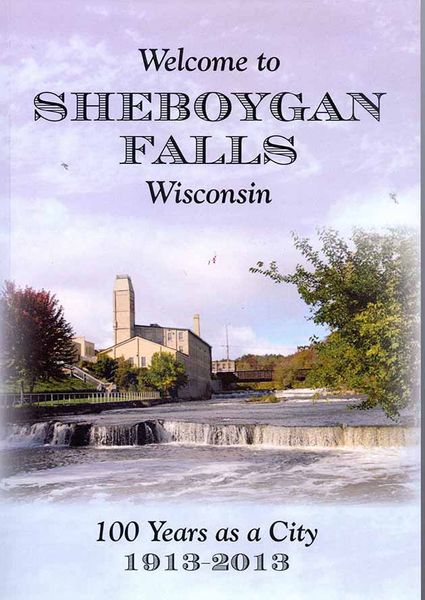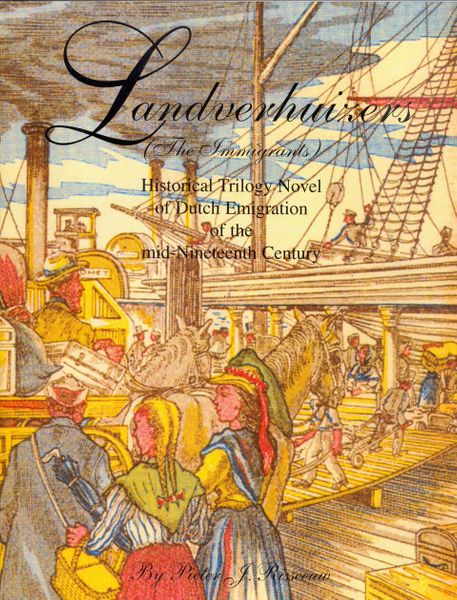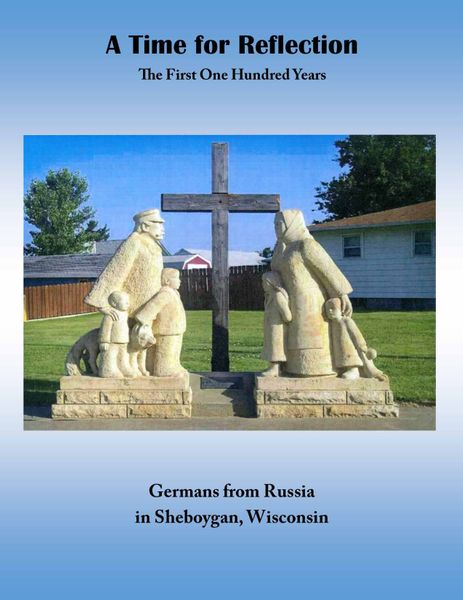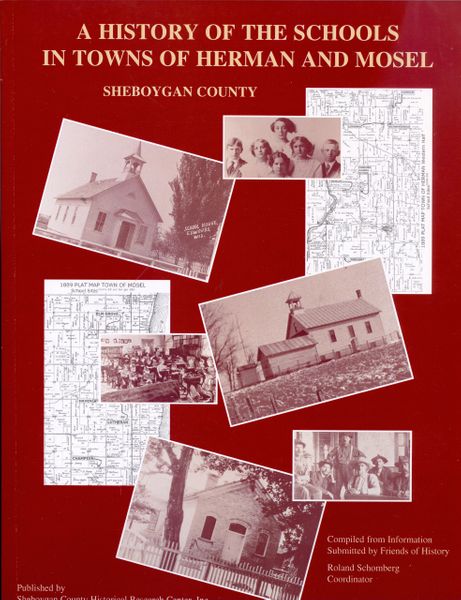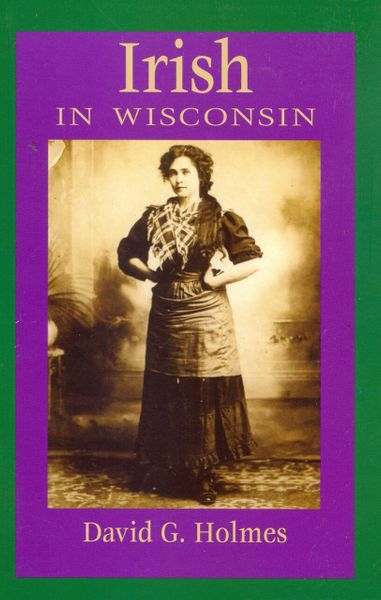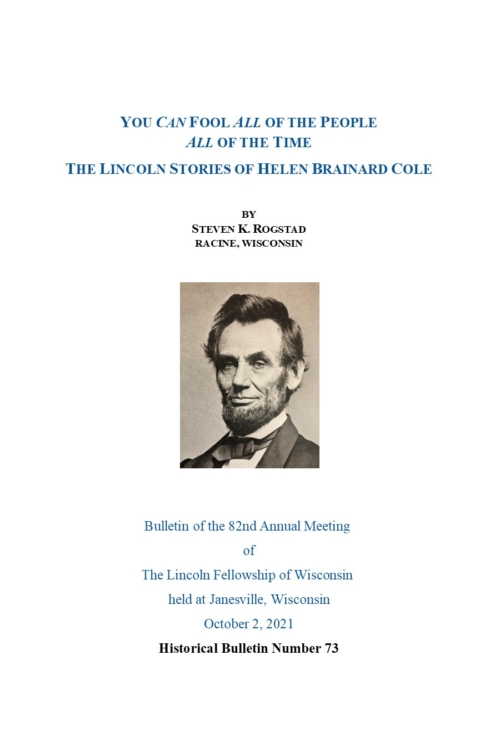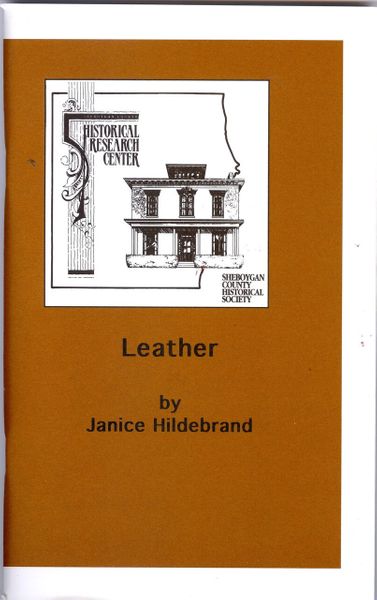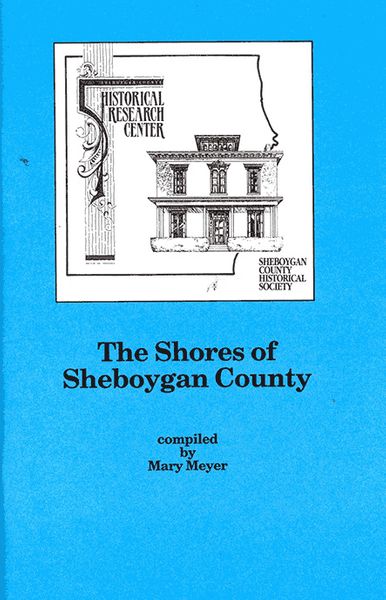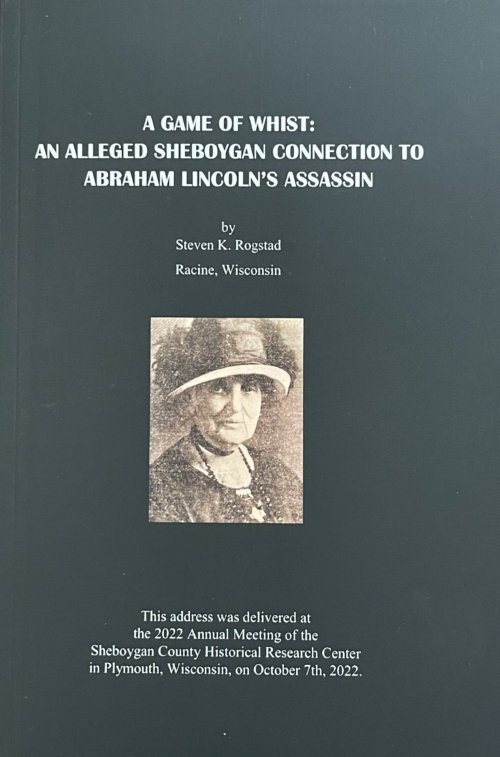-
Sale!This is a reprint and update of the 1976 book done for the Bicentennial. This book was done in conjunction with the 100th anniversary of Falls becoming a city. Trace the evolution of the business district and learn about the wide variety of civic groups which once kept citizens busy. See how the fire department has grown and take a peek at the folks who settled Falls
-
By Janice Hildebrand This book is a tribute to the City of Sheboygan in its sesquicentennial year 2003. The area that is now the city was settled years before 1853, but the city was not chartered until then. This book documents 45 men and women who were important in Sheboygan's early years. Each bio contains one or more photos. 2016 reprint.
-
Sale!By Earl and Charmaine Kneevers During the late 19th and early 20th century, there was a relatively strong Socialist movement in the United States. Sheboygan, Wisconsin was one of those cities that had an active Socialist Party. The movement believed in public ownership and democratic management of the basic means of production and distribution. It had strong ties to the organized labor movement of the time. A strong leader of the Sheboygan movement was Fred Kneevers, whose history as a struggling worker with a family to support and with Socialist beliefs, brought him into the hotel and restaurant business to support his family when known Socialists were not welcomed in privately run businesses. The Kneevers' Hotel was a successful meeting place of the Socialists.
-
By John Textor This is the story of the November 1847 sinking of the propeller ship, Phoenix, from a new perspective. Most of the fatalities were of new Dutch immigrants and this book tells of how life might have been different had the catastrophe not happened.
-
Sale!By Don Lau This book documents the growth of education in the City of Sheboygan. Did you know that Sheboygan had a Day School for the Deaf, A Fresh Air School- Tuberculosis- as part of the Third Ward School and was the first home of Lakeshore Technical College? Dozens of photos.
-
By Laura Chase Smith This history of the township of Plymouth, the Villages of Plymouth and Quitquioc, Sheboygan County, Wisconsin was written by Mrs. H.N. Smith. This series of articles was published in the Plymouth Reporter between December 10th, 1872 and June 5th, 1873. It details the lives of Plymouth’s earliest citizens.
-
Sale!Though we have nothing as dramatic as Pompeii, Mesa Verde or Petra, we, too, have lost settlements. Our lost settlements like Hoard, New Paris, Bear Lake, Gooseville and Hull’s Crossing are lost places of Sheboygan County- communities that were, for a short time, vibrant and busy, but fell into decline and disappeared except for the occasional mention on an old Sheboygan County map.We’ll take a trip back to reconnect with many of our local mysteries.Available about December 6, 2018.
-
Sale!
By Pieter J. Risseeuw
A historical novel, originally published as a trilogy, of Dutch immigration of the mid-nineteenth century. This English translation is made available for the first time by permission of the original publisher and supported by Netherland-America Foundation of New York. Originally published in Dutch in 1947, the novel discusses the trials and tribulations of immigration and the establishment of the Dutch churches and colonies in Iowa and Michigan.
-
Sale!This book covers Oostburg school history from 1899-2005. A great timeline gives the reader a wonderful overview of what happened educationally and socially in Oostburg, Wisconsin. Class photos and memories and reflections are included.
-
Sale!
By Bill Wangemann
This second book of Bill’s is a compilation of articles that appeared in the Sheboygan Press during 2004. Many are based on activities of the 1950s
-
A Time for Reflection 1892-1992 This booklet was prepared for a centennial celebration of the arrival of the first Volga Germans in Sheboygan, Wisconsin. That small group of seven, unsure of their destination or what they would do when they arrived, was followed by many other relatives and friends. Today, thousands of people who live in Sheboygan - or who lived there at one time - are descendants of German Russian immigrants. “A Time for Reflection” is our anniversary theme, for now is an appropriate time to reflect on our ancestors’ lives and to count the many blessings we have received as a result of their courage and sacrifice. With a new government in power, many Russian people of German descent will be searching for relatives and acquaintances in the West. Many Americans, too, want to be reunited with lost kin. We want to be ready to help each other. The history, chronology, and maps in this booklet represent only a small part of our unique heritage. Here is a brief look at the Volga Deitsch, how they got to Russia and why they came to America, and then to Sheboygan. It is a tale of more than 200 years of travel, hardship and joy endured by our ancestors. Older generations might recall the good times as well as the not-so-good when they read about old customs and practices. Younger people may learn a history they did not know existed. This 2016 update adds extra photos and more history.
-
Sale!
By Roland Schomberg
Originally published 1994, this 2008 update provides the reader with a look at the schools in the towns of Herman and Mosel from the town’s earliest history. Schools covered: Millersville, Howards Grove, Green Bay Road, Washington, Franklin, Pinehurst, Schwartzwald, Elm Grove, Haven, Champion, and Lakeview.
-
An entertaining compilation of great newspaper articles following the history of the railroad in Sheboygan County. Some are humorous, some are serious, and some are downright shocking. Great reading for the railroad enthusiast and amateur alike. 2016 Reprint.
-
By David Holmes The Irish have a rich and long history in Wisconsin, dating back to the 19th century. Immigrants quickly formed communities in Beloit, Fond du Lac, and Sturgeon Bay, as well as in rural Trempeauleau County. They worked at day labor, railroad construction, lumbering, fishing, and of course farming. Some of those early Irish communities have disappeared; others have experienced succeeding generations of Irish Americans settling in these Wisconsin cities and small towns and influencing them with their old country charm.
-
Sale!This publication is a chronological account of the sister city relationship between Sheboygan, a city in the state of Wisconsin, and Esslingen am Neckar of Germany. These articles span the years 1967 to 2017. The stories are told by actual headlines, story excerpts, photographs, and informational pieces gathered through articles in the Sheboygan Press, publications in the archives of the Sheboygan County Historical Research Center and Mead Public Library. The articles selected are meant to include a brief history and highlights of special visits and envoys. It is impossible to include everything. Many photos were available, but individuals and dates were not identified so they were not chosen. In a world that began with cablegrams, western union, letters, then phone and fax, communication evolved with the technology of cell phones, emails, the internet and FaceTime. In the beginning, travelers’ postcards and letters often arrived after they returned home. The bulk of the written material was found before all of this new technology replaced the newspaper stories. Some years there was more material than others. During the 1990s and beyond information was in the hands of individuals, not printed publications.
-
Sale!By Edwin L. Fisher Because of the prominence and close connection by virtue of the Sheboygan County Historical Society occupation of his 1852 mansion, it was thought more should be known about Judge David Taylor and his family. As a Wisconsin State Supreme Court Justice, he was one of the most important early settlers in Sheboygan, Wisconsin. As research proceeded so much interesting family-related information became available that the story expanded.
-
Sale!By Mary Jane Gruett Twelve year old Derk Van Vliet began the adventure of a lifetime in Holland in 1847. He left his home, his friends and his faithful dog, Bello, to begin a new life in America. But, disaster struck as his ship came within sight of its destination, Sheboygan, Wisconsin. The Phoenix, a Great Lakes steamer, normally delivered immigrants to their new homes. But, on Derk’s voyage, the doomed Phoenix, was part of an historic disaster which would cause Derk to question everything about life. He would have to forge ahead to find a new life and search to find courage deep within himself.
-
By Janice Hildebrand In Sheboygan County there was a lively trade with the Indians for deer hides and other animal skins. Barter with the Indians brought the first traders to the county in the early 1800s. The tanneries of the county were an offshoot of the fur-trading days and were among the first clothing-related businesses to get started in Sheboygan County. Everything from shoes to gloves to harnesses were made of leather. Follow the history of the leather business in the county.
-
Sale!By Richard A. Dykstra Here are thirty additional stories about growing up in rural Sheboygan County. Two favorite chapters are “The Airport” and “The Ice Box.” In the first you will appreciate the gullibility of children and in the second you will want to check Dykstra’s nose to see, if like Pinocchio, it has grown a foot or two. Besides the silly and nonsensical stories there are those with a much deeper meaning as in “Revisiting the Gift,” “Three Conversations with Dad” and “Grandma’s Quiet Life.” Dykstra's appreciation of family shines through the pages of all of his books.
-
By the Howards Grove Area Historical Research Committee The settlement of Haven, located in the Town of Mosel on the western shore of Lake Michigan, Sheboygan County, was formerly known as Seven Mile Creek, not Seven Creeks, as has been recorded in a newspaper account of the area’s history. It got its name from a small creek which flowed into Lake Michigan about seven miles north of Sheboygan. The first post office in Haven was established on July 16, 1897. The first postmaster in Haven was Frederick W. Franzmeier. In 1897 Frederick and Herman Franzmeier built a rooming house, tavern and store next to the railroad tracks. In 1903 the post office was established in that building.
-
Sale!By Elmer Koppelmann The citizens of Sheboygan County have always gone above and beyond the call of duty in times of military need; the Second World War was no different. Some 3000 young men and women served during World War II on all fronts and in all capacities from this county alone. Recorded here, after eighteen months of searches and interviews, are vignettes of 234 soldiers- one young woman and 233 young men from the Sheboygan County area who lost their lives. Four others- Joseph J. Archbold, Elmer C. Prahl, Roland Thompson, and Douglas Thornberg are noted as making the ultimate sacrifice, but regrettably, no information was found other than their names.
-
By Edmund Schulz Spring Corners is located at the intersection of County Trunk M and the Manitowoc-Sheboygan County Line, now known as County Line Road in the Township of Meeme in Manitowoc County and the Township of Herman in Sheboygan County. A spring flows continuously at Spring Corners, a place where people have come from far and near for a cool drink and to fill their water jugs for home use. This spring is part of a line of springs that form the Spring Valley
-
Sale!By Arthur G. Kroos, Jr This is the story of one Sheboygan County soldier, Arthur G. Kroos, Jr., from his enlistment in Company F, 127th Regiment, 32nd Division in the fall of 1940, until release in 1945. Mr. Kroos was chosen to serve a stint as Aide-de-Camp to General Matthew Ridgway. He was trained as a paratrooper seeing service in Northern Ireland, North Africa, Sicily, Italy and on D-Day in France. His final military foray took place in a glider as part of Operation Market-Garden. He was shot down over the Dutch island of Schouwen and spent eight months as a POW at Luft Stalag 1 in Barth, Germany. This book contains his own diary from Luft Stalag 1 and entries from a scrapbook created by his wife, Patty. This is not your average WWII story. It is local history at its best.
-
Sale!Since 1961, Mayors of Sheboygan have been elected to four-year terms and considered full-time mayors. Prior to 1961, Mayors were considered part-time mayors because the men had other jobs, while also serving as mayor. Starting in 1853, the men who ran for mayor were nominated by local political parties which many times made things interesting. There were times when the man nominated for mayor did not want the job. In the 165 year history of Sheboygan, little has been done to honor the men who served as mayor. This book is an effort to pay tribute to them and accurately, yet simply, document their political tenure. The vignettes that follow are in alphabetical order for ease of organization. Filled with photos this includes biographies of all of the city of Sheboygan’s part-time and full-time mayors.
-
By Mary E. Meyer
This book is a concise history of the port of Sheboygan, complete with photos of the harbor and the ships that plied its waters. Histories of harbor industries included.
-
Sheboygan, Wisconsin, known for years as "Chair City" has been home to such companies as Phoenix Chair, Northern Furniture Company, Mattoon, Crocker Chair, Bemis-Riddell, Thonet, R-Way and more. This book traces the history of furniture making in Sheboygan County from the mid-1800s to present day companies.
-
Sale!
By Bill Wangemann.
This is a collection of Sheboygan City Historian, Bill Wangemann’s 2005 and 2006 Sheboygan Press articles. Topics include Memories of Railroads, Electric Rail or the Interurbans, maritime stories- The Burning of the Niagara and The Mysterious Loss of the Pere Marquette 18, movies, TV and drive-in theater, Garton Toy and its fire, the stumpff fiddle and so much more.
-
In 1866, Cascade suffered serious setback when a fire wiped out practically the entire main drag including most of its businesses. By 1872, two flour mills, a saw mill, a bank, four grocery stores, a hardware store, three shoe stores, two blacksmiths, a wagon shop, a hotel and two churches had all rebuilt making the “newer’ wider main street. By the 1900 Cascade boosted a healthy business district that included wool carding, two cheese factories, two feed mills, three hotels, a post office, a physician’s office and a dentist office. In 1906 a group of business men held a meeting to discuss the future of Cascade. They came up with a list of things that they thought Cascade needed to continue growing: A fire company. A good library. A good policeman. A few more houses to rent. A number of good sidewalks. A parsonage for the United Brethren Church. Home protection from so many useless peddlers. A few more sheds to keep horses under in wet weather. More people to do less trading with the large firms in Chicago. A few more men to take the ladies out riding.
-
Sale!By Betsy Jones Michael This charming memoir by a Sheboygan author tells about a middle-aged wife, mother/stepmother who, in 1970, trains herself to ride a brand new ten-speed Schwinn Super Sports bicycle. She qualifies for bicycle tours in foreign lands, and finds her own home roads of Wisconsin best of all. Her adventures require physical stamina, discipline and independence and strangely, lead her to uncover mysteries of her mother’s early life, as well as those of her ancestors. She also rediscovers herself. The Green Steed was chosen by Sheboygan’s Mead Public Library for their summer 2009 citywide Sheboygan Reads, co-sponsored by the Sheboygan Press.
-
Sale!By Jim Carey Echoes from Home is a Civil War novel by Sheboyganite, Jim Carey. This is Jim's first entry into the world of publishing, but he's really been writing for twenty years. The book tells the story of Joshua Miller, survivor of the War of Secession. It is the story of a soldier from the south
-
Sale!By Paul Hanson In 1990, Sheboygan resident, Kathy Alby, started Earthfest to make the public aware of the environment. It was to be a celebration of our environment and a venue to show us what we could do to make positive changes—small or large—to make our world a better place in which to live. Originally held at Lakeview Park, the festival moved to Vollrath Bowl in 1992 and finally to Fountain Park where it thrives today. This book is photographic memory or remembrance by Paul Hanson of some of the people and events that make Earthfest the special summer event that it is.
-
By Elmer Koppelmann A fascinating look at Sheboygan County's presidential races from the beginning of the county's involvement in national government (1848) through the 1988 election where George Bush defeated Michael Dukakis.
-
Annual directory of the inhabitants, institutions, incorporated companies, manufacturing establishments, businesses, business firms, etc. in the City of Sheboygan. Published by Richard Edwards and company.
-
By Denny Moyer
This short book outlines the 100 year history of Baseball in Sheboygan, Wisconsin. Sheboygan's colorful history began with the Elwell Boys sponsored by Elwell Flour Mill and chronicles the many teams up to the present Sheboygan A's.

